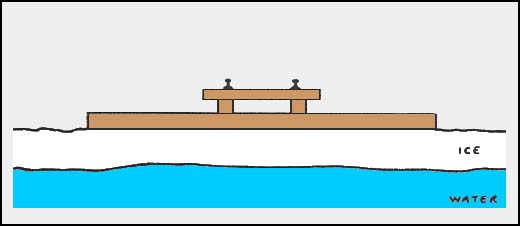
THE MONTREAL ICE RAILWAY 1880-1881
By Robert R. Brown
A Montreal ice railway train on the St. Lawrence River - 31 Jan 1880 Photographer? - McCord Museum II-61419.0.1.
One of the most curious and interesting railway ventures in Canada was the famous railway built across the ice of the St. Lawrence River, between Montreal and Longueuil, during the winters of 1880 and 1881. Previous to the construction of the Canadian Pacific Railway bridge at Lachine, near Montreal in 1887, the only railway bridge across the St. Lawrence was the Victoria, owned by the Grand Trunk Railway and that Company was not very friendly to rival lines and practically refused to allow them the use of the bridge. During the 1870's two railways of considerable size were built, the South Eastern Railway, on the South side of the St. Lawrence, extending from Longueuil, opposite Montreal, to Newport, Vermont, and with branches to Sorel, St. Guillaume, and Frelighsburg, while on the North shore of the St. Lawrence, the Quebec Montreal Ottawa & Occidental Railway (QMO&O) had lines extending from Montreal to Quebec and to Ottawa. In January 1880, Mr. L.A. Senecal, who controlled the South Eastern, was appointed General Superintendent of the QMO&O which had just been built by the Provincial Government. These two railways had not been very successful but it was hoped that by exchanging traffic and working together it would be to their mutual advantage. The QMO&O needed an outlet to the United States and the South Eastern was the only one not under the control or influence of the Grand Trunk.
For financial reasons, a bridge across the river was out of the question, so the directors of the two railways decided to try a scheme that had been proposed several times in the past, but which no one had had the courage to try. A subsidiary company, La Compagnie de Traverse de Chemin de Fer d'Hochelaga a Longueuil, was formed to build a connecting line across the ice in winter and to operate a car ferry in the summer. There were many doubts and some ridicule, and the papers of the day were filled with letters, pro and con, from such well-known people as Constant Reader, Subscriber, Pro Bono Publico, and others.
Small holes were bored in the ice to gauge the thickness, and it was found that the ice varied from 2 to 4 feet in thickness, and was quite solid enough to support the weight of a light train. Early in January work was started, grading and leveling the snow and ice, from the South Eastern terminus at Longueuil across to the QMO&O tracks near the Hochelaga station in the city of Montreal, a distance of 3,000 yards. To distribute the weight over a large area of ice, cross timbers, 12 x 12 inches, varying in length from 12 to 24 feet, were laid on the ice, and then timbers of similar dimensions were laid longitudinally on top of them and spiked down. Then on top of the longitudinal timbers, ordinary ties were laid and spiked and light iron rails completed the structure. The line was completed on 29 Jan 1880 and loaded cars were hauled, by horses, across to Montreal.

Details of track structure - 19 Feb 1880 Artist? - L'Opinion Publique.
The official inauguration took place two days later, on Saturday, 31 Jan 1880, when a train consisting of a small locomotive, the "W.H. Pangman", and two flat cars fitted with seats and railings, set out with a load of Government, Civic, and Railway officials, plus guests, while other less venturesome guests crossed the river in sleighs. The train was gaily decorated with flags and evergreens and a large stuffed beaver was mounted on the pilot of the engine. The locomotive weighed about 25 tons, the two flat cars about 8 tons each, and the 250 passengers probably brought the total weight of the train up to about 60 tons. There was great excitement as the train started out over the ice, especially as the weight of the train caused the water to bubble up through the cracks and holes in the ice, and the spectators on shore fully expected to see the passengers get a cold and sudden bath. However, the train continued on its way at about 10 miles per hour, and finally, after having stopped for a few minutes at the middle of the river while photographs were taken, arrived at the South Eastern station at Longueuil, where refreshments were served by the proprietor of the nearby Richelieu Hotel. Toasts and speeches followed, but despite the gratifying result of the experiment there were still many who had misgivings.
The line was used about two months, though horses replaced the locomotives after the middle of March, and by the end of that month the ice began to be insecure, so the track was taken up. By 17 Apr 1880 the river was clear of ice and the new car ferry, the "South Eastern", started running. Traffic had been handled without much difficulty, practically the whole winter, so the following winter the track was laid on the ice again, but after a few days the men in charge became over confident and took 17 loaded cars over to Longueuil in one train, thus weakening the ice. Returning to Montreal, the locomotive, the "St. Pie", had just left the south shore when there was a loud crack, men were seen jumping from the train and the locomotive plus two cars gradually disappeared from view, sinking to the bottom of the river where they remained until the following summer. The numerous critics were jubilant and the enterprise had to be abandoned.
It is related how after the accident someone asked, "Well, Mr. Senecal, when is your train going to leave?" To which he replied, "Wait a bit, the locomotive has just stopped to take on water." The ice railway was never again attempted, and during that and succeeding winters passengers and freight were taken across the river in sleighs, until a few years later when both the South Eastern and the QMO&O were acquired by the Canadian Pacific Railway, which were then connected by the new St. Lawrence Bridge at Lachine, a few miles above Montreal.
The Montreal Ice Railway 1880-1881 - Robert R. Brown - The Railway and Locomotive Historical Society Bulletin No. 22 (May, 1930) pages 42-45 published by the Railway & Locomotive Historical Society (R&LHS).



